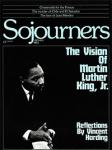We were busily working toward the magazine deadline when the news came. Someone had driven a truck to the Washington Monument and was threatening to blow up the structure in an effort to stop what he called "this madness" of nuclear weapons. Claiming that his truck held a thousand pounds of explosives, the man made a number of vague demands, including the initiation of a nationwide dialogue on the arms race and the devotion of 51 per cent of media coverage to the question.
We listened throughout the day, and finally the radio news informed us that the name of the truck's driver was Norman Mayer. He was described as a 66-year-old man who had grown increasingly distressed with the endless spiral of nuclear weaponry. He had reportedly spent more than $30,000 in newspaper ads and leaflets trying to get people to do something about the arms race.
Scott Duffy, a member of the Catholic Worker who works part time at Sojourners, had met Mayer a week before in front of the White House. Like Mayer, Scott was there, on the day that Reagan had announced his MX decision, to protest nuclear weapons. Mayer came over to talk to him.
"It's futile," he told Scott. "It won't do any good. I've been trying for years, and no one will listen to me." He said that he was not a pacifist and had no religious faith. Scott recalled that Mayer didn't seem crazy, just frustrated and desperate.
As Mayer, dressed in a blue jumpsuit and visored motorcycle helmet, circled the monument, the area around was quickly evacuated and surrounded by police. Eight people were initially trapped at the top of the monument, but Mayer allowed them to leave after a few hours. At the end, he could only kill himself. The blast could blow out windows in nearby buildings, but would not seriously damage the 15-foot-thick granite and marble walls of the monument.
At 7:30 p.m. the truck began to pull away. The police opened fire, the truck swerved and tipped over, and Norman Mayer was dead with two bullets in his head. Believing there was an accomplice inside, police tear-gassed the monument. But Mayer had acted alone. A thorough search of the truck found no explosives.
The event was as strange as it was tragic. The next morning's Washington Post carried the headline "Nuclear Foe Holds Monument Hostage." One woman in our office commented that a man was shot for holding a monument hostage because he was desperate about the arms race, while government leaders hold the world hostage with nuclear weapons every day. Bill Moyers made a similar point on the CBS Evening News: Mayer had the superpowers as his role models; while one sort of maniacal behavior was going on at the monument at one end of the mall, at the other, Congress was continuing to fund a defense policy no less maniacal.
Mayer said he chose the Washington Monument because "it is one of the sacred icons and is accessible." He thought that threatening to blow up the monument might for the first time make the country and its leaders listen to him and do something about the threat of nuclear war.
I wondered whether we had just witnessed an isolated act of personal despair, or whether we will see more of such frenzied attempts in the days ahead. As awareness of the nuclear peril rises and government leaders continue unabated in their course of arms escalation, fear and frustration will likewise rise, perhaps leading to a widespread desperation.
Government imperviousness to public anxiety concerning nuclear war could especially lead those without faith or hope to behavior more rooted in fear of nuclear war rather than in a commitment to peace. In the face of this situation, the peace movement will need to become even more disciplined in its nonviolence.
As awareness and fear increase, who will provide the needed pastoral support, calling people to a faith that does not produce passive resignation, violent reaction, or hopeless despair, but rather engenders the strength, determination, and courage necessary to persevere and sacrifice for peace?
At our office we grieved for Norman Mayer and wondered why the police had felt it necessary to shoot him. He will hardly be remembered as a martyr for peace, but rather as a tragic example of the desperation that our future holds, unless we are able to turn from our present course and rid ourselves of nuclear weapons.
Jim Wallis was editor of Sojourners when this article appeared.

Got something to say about what you're reading? We value your feedback!
